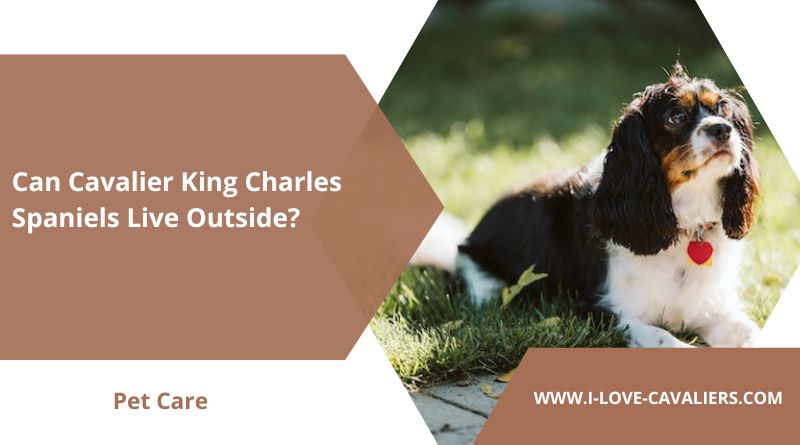As the proud parent of a Cavalier King Charles Spaniel, or if you’re considering becoming one, you’re part of a growing group of enthusiasts who have fallen for the charm of these affectionate and playful dogs.
However, a question that often arises among potential and new owners is whether Cavaliers can live outside. So, in this blog post, I’ll delve deep into this topic, examining the physiological and behavioral traits of Cavalier King Charles Spaniels that make them more suited to indoor living.
I’ll share my thoughts on the potential hazards of outdoor living, while also outlining ideal living environments for your four-legged friend.
Can Cavalier King Charles Spaniels Live Outside?
Cavalier King Charles Spaniels shouldn’t live or sleep outside due to their sensitivity to extreme temperatures, vulnerability to predators and thieves, and susceptibility to diseases. As a breed, they have inherent health issues that can worsen in outdoor conditions. Additionally, Cavaliers’ need for human interaction further confirms that an indoor lifestyle is most suitable for them.
However, while indoor living provides suitable living conditions for Cavaliers, this doesn’t mean they should be completely deprived of outdoor activities. As a matter of fact, regular access to the outdoors is very important for their health and happiness.
5 Risks of Outdoor Living for Cavalier King Charles Spaniels
Living outdoors poses certain risks and potential hazards for any dog, but for breeds such as the Cavalier King Charles Spaniel, these risks may be even more pronounced.
Let’s discuss potential dangers.
Exposure to Extreme Weather Conditions
Cavaliers’ distinct “pushed in” faces, or brachycephalic features, may be adorable, but they come with their own set of problems. These physical quirks result in a constrained breathing pathway, making dramatic temperature swings dangerous for them.
In other words, their susceptibility to heat stress can lead to overheating in high temperatures, a risk that can sadly prove fatal in as little as half an hour.
Increased Vulnerability to Predators and Thieves
As lap dogs, Cavalier King Charles Spaniels could potentially be seen as an easy target for larger predatory animals. Beyond the natural world’s dangers, we also need to consider a man-made threat – theft. Cavaliers are expensive dogs, and dog thieves are well aware of that.
Risk of Disease and Parasites
Outdoor living can expose Cavalier King Charles Spaniels to various parasites, including fleas, ticks, and heartworms, which can lead to serious diseases. They may also be at risk of contracting infectious diseases from other animals.
Psychological Stress
Cavaliers don’t just like human interaction; they thrive on it. If your heart is set on a Cavalier, but you’re planning for it to live outside, it would be better to look for other breeds.
Being left alone outside can cause them significant emotional distress and anxiety, leading to behavioral and mental issues.
Higher Chances of Health Problems
Cavaliers, as a breed, are prone to various health conditions. Some of these include heart diseases (such as mitral valve disease) and joint issues. Damp, cold conditions can worsen joint issues, while stressful situations such as being lonely can exacerbate heart problems.
So, the bottom line is that while Cavaliers can spend enjoyable and beneficial time outside, they are not a breed that is adapted to living outdoors permanently or for extended periods.
The Ideal Living Conditions for Cavalier King Charles Spaniels
When considering the ideal living conditions for Cavalier King Charles Spaniels, keep in mind that they have been bred to be companion dogs.
Room to Roam
Although Cavaliers are petit doggies, they still love to have a bit of personal territory to frolic around just like any other breed. Apartments or compact homes? No problem. Cavaliers adapt like champs.
But remember, they’ll need their own playful space. It doesn’t need to be a doggie Disneyland; a snug corner where they can chase a toy or engage in a game of fetch works wonders.
A Companion’s Need
One of the key traits of Cavaliers is their fondness for human interaction. So much so, they become your shadow. These little “love sponges” soak up every ounce of attention you can give.
Therefore, if your home is more silent retreat than a bustling family hub due to work or school commitments, consider arranging a dog walking service or ask a neighbor to take care of your dog.
Adapting to Weather
I’ve nudged at this before, but it’s worth hammering home that Cavaliers and extreme weather go together about as well as cats and swimming. When summer heats up, avoid walks during the scorching midday sun. Always pack fresh water to fend off dehydration.
Conversely, in the colder months, limit your Cavalier’s time outside and consider doggy sweaters or jackets to keep them warm. These extra measures will ensure your pet stays comfy and healthy, no matter the forecast.
What Temperature is Too Cold For Cavalier King Charles Spaniels?
Cavalier King Charles Spaniels, like all dogs, are affected by the environment they inhabit. However, their small stature makes them more susceptible to extreme weather conditions because they have less body mass to generate warmth, and consequently, they can lose body heat quickly.
As a general rule of thumb, when temperatures start to fall below 40 degrees Fahrenheit (4 degrees Celsius), Cavaliers may begin to feel uncomfortable. They are not built for cold climates, and their coat, while beautiful, doesn’t provide them with the necessary insulation.
Furthermore, when the mercury drops below freezing point, at 32 degrees Fahrenheit (0 degrees Celsius), it becomes not just uncomfortable, but potentially hazardous to them. Since Cavaliers are prone to respiratory problems, they may experience breathing difficulties when exposed to cold weather conditions.
